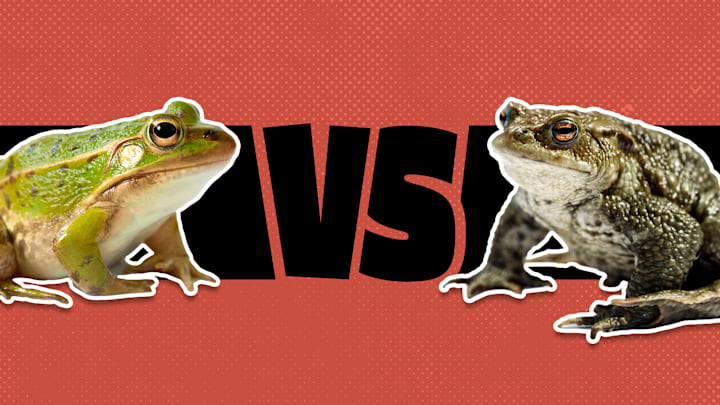If you’ve thought about the frog versus toad question at all, you’ve probably assumed that these amphibians are two very different animals. But the real answer might surprise you: Toads belong to the order Anura, and are actually a subset of frogs. “All toads are frogs, but not all frogs are toads,” Christopher Raxworthy, now curator of herpetology at the American Museum of Natural History, told Mental Floss in 2015. “In popular use, toad seems to be used to refer to any frog that has a dry warty skin and short legs.”
- Differences in Appearance
- Different Habitats
- Differences in Spawn
- The True Toads
- Read More Articles About Animals:
Here’s how you can tell the difference between frogs and toads—and how true toads fit into the equation.
Skin | Preferred habitat | Locomotion | |
|---|---|---|---|
Frogs | Smooth, moist | Water | Leaping, swimming |
Toads | Bumpy, dry | Dry land | Hopping, walking |
Differences in Appearance
Frogs and toads have different kinds of skin. If you see an animal that has dry and pebbly skin, you’re looking at a toad. (Don’t worry—touching a toad won’t give you warts. That’s a myth.) Frog skin is moist and smooth.

Frogs have slim bodies and long legs—which are better for long leaps and fast swimming—whereas toads have short forelimbs and hop or walk. Toads also have big glands behind their eyes, called “paratoid glands,” which produce poison.
Different Habitats

The amphibians also prefer different habitats: Frogs like to be in water to keep their skin moist. Toads, on the other hand, are most often seen on land; they have skin that’s better at retaining moisture, so they can wander farther from bodies of water.
Differences in Spawn
Both frogs and toads breed in water, but their spawn looks different: Frogs lay their eggs in clusters, and toads (generally) lay their eggs in long chains. According to Discover Wildlife, frogs are capable of breeding and spawning in colder temperatures than toads.
The True Toads
There’s also a group scientists call true toads. They belong to the family Bufonidae, which consists of 50 genera and nearly 600 species, native to all continents except Antarctica and Australia (the cane toad, currently marching its way across Australia, was brought there in the 1930s). “They are recognized as a natural group based on DNA and skeletal characters,” Raxworthy said. For example, true toads don’t have any teeth, and the skin on the head is typically ossified to the skull.

But even in that group, the distinction between toad and frog isn’t necessarily clear. “Many have a dry warty skin, but not all,” Raxworthy said. If you saw a member of the genus Atelopus, you’d probably assume it was a regular frog—but these colorful amphibians, which hail from Central and South America, are also true toads.

And any number of frogs get called toads, even though they actually aren’t, like those in the Bombinatoridae family. Nature: It’s complicated!
Now that you know the difference between frogs and toads, read up on the difference between a cricket and a grasshopper, bison and buffalo, and pigeons and doves.
Read More Articles About Animals:
A version of this story ran in 2015; it has been updated for 2024.
